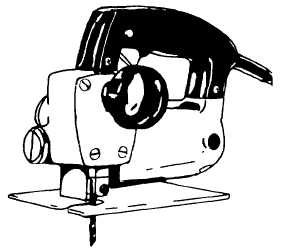ripping guide is set a distance away from the saw equal to the width of the strip to be ripped off. It is then placed against the edge of the piece as a guide for the saw. To make a bevel angle cut up to 45° (view B), you just set the bevel adjustment knob to the angle you want and cut down the line. To make a pocket cut (views C and D), a square cut in the middle of a piece of material, you retract the guard back and tilt the saw so that it rests on the front of the base. Then, lowering the rear of the saw into the material, hold it there until it goes all the way through the wood. Then, follow your line.
Observe the following safety precautions when operating a circular saw:
Don't force the saw through heavy cutting stock. If you do, you may overload the motor and damage it.
Before using the saw, carefully examine the material to be cut and free it of nails or other metal objects. Cutting into or through knots should be avoided, if possible.
Disconnect the saw from its power source before making any adjustments or repairs to the saw. This includes changing the blade.
Make sure all circular saws are equipped with guards that automatically y adjust themselves to the work when in use so that none of the teeth protrude above the work. Adjust the guard over the blade so that it slides out of its recess and covers the blade to the depth of the teeth when you lift the saw off the work.
Wear goggles or face shields while using the saw and while cleaning up debris afterward.
Grasp the saw with both hands and hold it firmly against the work. Take care to prevent the saw from breaking away from the work and thereby causing injury.
Inspect the blade at frequent intervals and always after it has locked, pinched, or burned the work. Disconnect the saw from the power source before performing this inspection.
Inspect daily the electric cords that you use for cuts or breaks. Before cutting boards, make sure the cord is not in the way of the blade.
Saber Saw
The saber saw (figure 3-18) is a power-driven jigsaw that cuts smooth and decorative curves in wood and light metal. Most saber saws are light-duty machines and not designed for extremely fast cutting.
There are several different, easily interchangeable blades (figure 3-19) designed to operate in the saber saw. Some blades are designed for cutting wood and some for cutting metal.
The best way to learn how to handle this type of tool is to use it. Before trying to do a finished job with the saber saw, clamp down a piece of scrap plywood and draw some curved as well as straight lines to follow. You will develop your own way of

Figure 3-18.-Saber saw.

Figure 3-19.-Saber saw blades.
Continue Reading